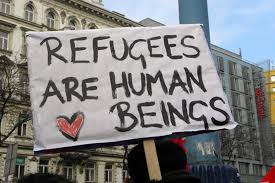Mariam Farid Khwaja
“Refugees have been deprived of their homes, but they must not be deprived of their futures” remarks Ban Ki Moon, the Secretary General of United Nation. There must be no hesitation in upholding what Mr. Ban Ki Moon states. Not only are States obliged by their domestic laws to protect the rights of its citizens and even non-citizens which certainly includes Refugees and Asylum takers; International Community through its various conventions and treaties also places legal duties upon Host States to endorse the fundamental rights of those who have been deprived of their homes and have to take refuge in another country. Yearly, International Conferences, Seminars and Talks on Refugee Crises are held to foster such aspirations. Refugee’s Rights today are an International Mantra which holds place in almost every major Human Right Convention that has been written till today.
This paper deals with the issue of Rights of Refugees in relation to the Customary International Law and Human Rights instruments. It looks at the example of the Afghan Refugee Crises to firstly, outline the rights of Afghan Refugees and the Duty of the Pakistani State in relation to their rights under the International Law. Secondly, it assesses the structural limitations which hinder Pakistan in protecting the Rights of Afghan Refugees. An assessment of such structural limitations is important because a third world country like Pakistan is already overstrained by economic plight, security dilemmas and social and cultural predicaments. Can a state burdened with such structural and endemic problems; on its own fulfill such an enormous and colossal duty?
If the answer to the above proposition is in negative, what role should the International Community play in rehabilitating, relocating and repatriating such refugees? It should be noted that Refugee Crises is an International Issue and the host state alone should not be responsible to cater to such a colossal task. Till now, the role of the International Community though has been aspiring and hopeful, the substantial assistance Host States received from the International Community paints a disappointing picture. According to a UNHCR report, world’s wealthiest nations contributed less than $1 billion-one tenth the amount they spend on maintaining their own asylum system- to fund UNHCR’s protection work around the world.
The historical origin of International Human Rights legislation on Refugee Rights can be traced to the devastating result of the World-War 2. In the wake of the war, millions of Europeans were left with nowhere to go. There was a need to provide legal protection to such Refugees until the war was over. While generally the Host State was accommodating towards the influx of Refugees, there was a need of affirmative action from the States to protect the rights of such refugees. Therefore, for the displaced people in Europe after the war, the United Nations Relief and Rehabilitation Agency (UNRRA) and the International Refugee organization (IRO) were created. Although, there existed a League of Nations Convention 133 or the Convention of 1938 on the Status of Refugees coming from Germany; firstly, these conventions only imposed obligations on those who were signatories to such conventions and Secondly, these were not comprehensive International Legislation on the protection of the rights of the refugee since they had a specific role in relations to historical events.
In 1951, the convention relating to the Status of Refugees was adopted which came into force in 1954. The reason for adopting this convention as mentioned in the UNHCR handbook is,
“Instead of ad hoc agreements adopted in relation to specific refugee situations, there was a fall for an instrument containing a general definition of who was to be considered a refugee”
This binding convention was accepted and codified in many other human rights institutions[1]. The Convention places obligation on States to protect the rights of Refugees. Under Article 33 of the 1951 Convention the countries are under obligation not to return the refugees to the country from where they would fear the risk of persecution[2]. These are obligations more commonly referred to be based upon the principle of non-refoulement.
Although convention has imposed duty on the sovereign states to protect and provide the refugee with the rights[3] but some states have barred the refugees with certain rights such as freedom of movement, access to public relief or access to the formal labor market.
The 1951 convention imposes duty on the states to provide the refugees with basic rights which the citizens of the country are entitled to it without any discrimination[4]. These rights include freedom of religion,[5] access to the national courts; education and health facilities. The Convention states that the rights provided to the refugees need to be as favorable as to the nationals of the state.
Chapter III of the convention set out the employment rights of the refugee.[6]. Chapter IV of the convention states that the refugees should be given equal rights to housing and obtaining properties in the host countries just like the national of the country. The UN conference in 1951 called the government to deal with the family reunification issue of the refugees; first to where the head of the refugee family has fulfilled the conditions then the family should be united, the second point deals with the protection of the minor refugee specially with reference to its guardianship and adoption.
The highly volatile and unstable Afghanistan since the last three decades has led to around three million Afghan Refugees finding safe shelter in the neighboring Pakistan. Many International Donor Agencies including UNCHR have been funding for their food, shelter and health concerns. While 42% of Afghan Refugees have been provided shelter by UNCHR by setting up various camps in Khyber Pukhtunkhwa province of Pakistan, 58% of the Afghan Refugees still live on their own in various urban cities including Karachi, Lahore and Islamabad. This has lead to security dilemmas since many Afghan Refugees have joined banned militant outfits such as Taliban Pakistan and carry a potential threat to the security framework of Pakistan. Moreover, the constant influx of Refugees also poses a heavy burden on the already crumbling economic affairs of Pakistan.
The issue of Afghan Refugees surfaced in 1979 during the Soviet Invasion and it reached its pinnacle with the Mujahedeen resisting the Soviets. Since, Pakistan was an ally of the Americans and was funding and harboring the Mujahedeen, proper documentation of these refugees was not in the priority list of the Government. Furthermore, the problems these Afghan Refugees would create for the incumbent State in the future was never in the mind of those who opened the flood gates for the Afghan Refugees. It was only during the last decade that Pakistani Government felt it necessary for the proper documentation. However by then, the issue had become more complicated. The 2002-2003 War on Terror had lead to an increase in the inflow of Afghan Refugees. The only comprehensive report which was released in March 2006 pictures that the number of Afghan Refugees has gone up to over three million and that the resources and operational capacity of the Government of Pakistan is not sufficient for repatriation. It is also to be kept in mind that these official figures in no way represent the actual number of refugees living in Pakistan since many of them left for urban cities to find work without being properly documented.
On the other hand, the response of the Pakistan Government has been to forcefully shut down these camps and send the Refugees back to Afghanistan. On March 13, 2006, it was announced on the Government’s Radio that the Government would be shutting down the biggest refugee camp in Khyber Pukhtunkhwa. More recently Pakistani Paramilitary Forces launched an operation in Camp Miramshah as it was suspected that those Afghan Refugees suspected to have joined Taliban were finding the camps to be a safe hiding place. This Pakistani response has not settled well with the Afghan Refugees. They blame the Pakistani Government for denying them their right of camp life as enshrined in International Law. This has further lead to their insecurity, vulnerability and poses greater problems for them. It is also to be seen that the camp closure has not been a successful policy, since many Afghan Refugees rather than going back to Afghanistan relocate themselves to either other camps or to urban cities, Karachi being their most likely destination. The recent Pakistani Military offensive against suspected Taliban in the mountainous region of Swat and the ongoing operation in Karachi is a by product of the Afghan Refugees relocation to these major cities.
UNDP has yet failed to properly help, support and assist the Pakistani Government and the Afghan Refugees in repatriation and Rehabilitation. The reason is that the insecurity and volatility of the region does not allow for proper assessment. To this end, the Government of Pakistan has been requesting the International Community to improve the social, economic and cultural conditions in Afghanistan to make the rehabilitation of these Afghan Refugees possible. In a nutshell, the Pakistani Government feels that unless pull factors are strong, comprehensive repatriation is less likely to be successful.
In early April 2005, the Pakistani Government closed down 12 major Afghan Refugee camps in North Waziristan Agency of FATA citing security reasons. This move created anxiety and apprehension among almost 100,000 Afghan Refugees who rushed to UNHCR Camps in Pakistan complaining about Pakistani Security Forces as well as Political Administration forcefully evicting them from their camps. The majority chose to repatriate while other relocated to other existing camps. The return of a large number of Afghan Refugees was a major blow to UNCHR operations in Afghanistan. Many Refugees returned to find limited development and worse conditions in Camps set by UNCHR. While there were economic issues involved with the major relocation of the Afghan Refugees, there was also a societal problem involved with reintegrating the Refugees with their former communities.












